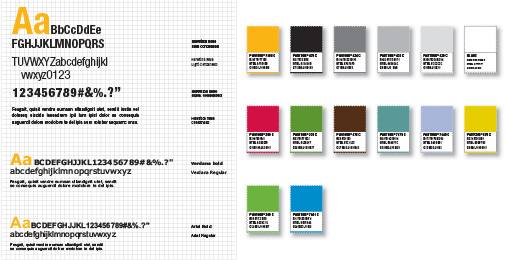A website consists of templates, that is to say, page templates (form), and content (substance).
The content has its own framework: the online editorial guidelines (or digital)
The form also has its framework: the online graphical guidelines (or digital)
Both are extremely important to control your digital assets, deploy and optimize them over time. We will focus here on the online graphical guidelines, that is to say on the form, and give you the right track to be able to write it and make it understandable to all your service providers or stakeholders, and to answer all your goals, depending on your context and needs.
Why have good online graphic guidelines drafted and updated?
First mistake: using your offline graphical guidelines for digital projects.
This is a common situation: with no digital graphical guidelines some use their offline graphical guidelines for their website.
#wasteoftime #ineffective #unsuitable
In fact, your offlinegraphical guidelines don’t take into account the crucial elements specific to digital projects:
- Size and screen resolution
- Logo versioning for web projects: we recommend to use horizontal logoversions instead of vertical versionsin order to save some room for reading comfort.
- Effect on clickable items (menu, links etc.)
- The screen colors, etc.
The lack of online graphical guidelines or the presence of an incomplete online graphical guidelines cause everytime waste of time and frustration for clients and agencies, and more generally for every stakeholders of the project:
- If the graphical guidelines are incomplete, the deliverable will look like a picture, without interactivity
- If the graphical guidelines don’t exist, the agency may take initiatives that do not always match with the customer’s needs.
Having digital graphical guidelines allows you to:
- Work with multiple service providers and at the same time with a common framework: you are then more efficient,
- Gather knowledge on your digital assets and thus make it more accessible,
- Be quicker in case of rebranding,
- Be quicker in case of deployment (cities, BUs, countries, jobs, activities, etc.)
- Be quicker when creating new brands and picking up existing elements in the case of creation of new digital media (such as a new social network)
Which media are concerned by digital graphical guidelines?
It’s not only your website that will be concerned by this document. There will also be:
- Illustrations you will broadcastover the Internet
- Newsletters or emailings
- Online videos
- Online advertising campaigns (eg Adwords, banners)
- Social media
- Advertorial contents
What are the risks of unoptimized or incomplete online graphical guidelines:
- Longer briefings or RFPs
- Less accurate briefing returns
- Longer projects with more backs and forwards
- Longer testing and delivering stages
- Getting familiar with your digital assets will be more tricky for new employees because less controlled
In conclusion, such a document, well written and updated, saves you time and therefore money.
You will find below, via the download and sharing link, all the elements that should be found in your online graphical guidelines (also called digital graphic guidelines).
If you need advice or support to launch or redesign your website (specifications, features, tests, etc.) please contact us.
